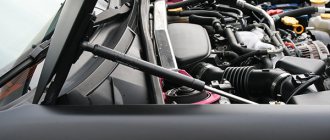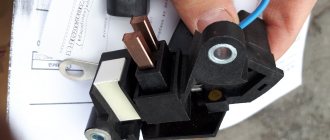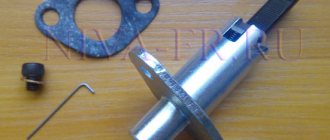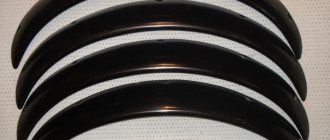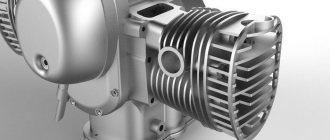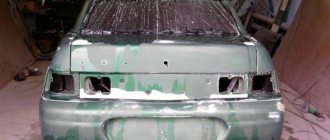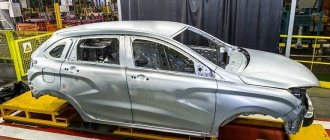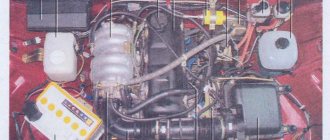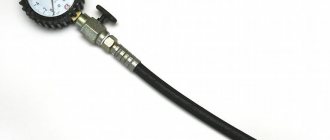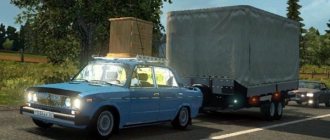Renewing paintwork is a service that is in great demand. Sometimes clients order repainting of the entire car, more often - painting of individual parts that have been in an accident (or new parts to replace damaged ones).
If a car is being painted in a room, it must be equipped with a powerful ventilation system. The owner of the box has 2 options: purchase a factory paint booth, which already has a built-in ventilation system, or organize the right conditions in an empty room.
Let's look at how to organize it correctly.
Preliminary advice : designing and installing ventilation equipment for painting booths is a responsible task. You cannot work without a ventilation system, even if you have a garage where you cheaply paint scratched fenders and doors for old domestic cars - because a violation of air exchange can lead to a fire or poisoning.
If we are talking about a “full-fledged” paint booth that is officially operating, the ventilation system for it must be designed by specialists. All information below is for informational purposes only.
Is it necessary to provide ventilation in the paint booth, and why?
Yes , definitely .
The ventilation system in paint booths performs the following functions:
- Cleans the incoming air from dust and dirt that can settle on the paintwork.
- Filters the exhaust air from harmful substances and odors. They also harm the environment and can be dangerous (and the smell is unpleasant) if the spray booth is located near people. For example, if you are painting a car in your garage, and there are garages of other car owners nearby. In this case, we are talking not only about the discomfort of neighbors, but also about violation of sanitary standards. If the maximum permissible concentration of harmful substances due to your work exceeds the norms, wait for the Sanitation Station.
- Removes harmful substances that are released during painting and can harm the painter. The most important factor, since paints and varnishes contain substances of hazard classes I and II (“extremely dangerous” and “highly dangerous”), including those that penetrate the body through the skin and digestive tract (from dirty hands).
- Removes vapors from explosive substances. Xylene is released from paintwork materials, and white spirit (a highly flammable substance) and solvents that contain it are also dangerous.
If there is insufficient air exchange, painting even one car can harm the health of the car painter. And if you decide to paint for a long time in a closed small garage, you can get acute poisoning from paint vapors.
Therefore, even if we are talking about repainting 1 spare part, sufficient air exchange must be provided for the work.
Security measures
The main purpose of installing a ventilation system is to ensure the safety of painters. When painting, a large number of particles of paint, solvent, and varnish enter the air. A toxic mist appears that causes discomfort to the mucous membranes during breathing. Proper ventilation should press the resulting “fog” to the floor with a vertical air pressure.
Employees must also use protective equipment:
- respirator;
- gloves;
- protective clothing;
- mask and glasses;
- closed shoes.
The room must be finished with fire-resistant materials; there should be no sources of open fire; The wiring is carefully insulated.
Cabinets, equipment, and any other items are removed from the spray booth so that dust does not accumulate on them and they do not interfere with ventilation.
General requirements for the ventilation system of a paint booth
Let's list the main rules:
- Ventilation should be only mechanical (forced).
- Filters must be installed on both the supply and exhaust.
- Ventilation equipment must be explosion-proof.
- Air is supplied through the ceiling, flowing vertically downwards. Exhaust hood - organized through floor gratings.
What is taken into account when designing? (+video with general information)
That's what:
- Car size. The size of the chamber itself depends on this - it should not be too large, since then a more powerful ventilation system will have to be made. The average size of cameras for passenger cars is 6.9x3.9x2.7.
- Type of paint (to know the composition of paintwork materials, type of solvents). Based on this, better filters can be selected.
- How often do you plan to paint, and how long will the work take?
How can you simplify everything?
To reduce the cost of purchasing expensive equipment, using the box occasionally, you can increase the efficiency of even the simplest ventilation system. For this purpose, operation is provided in active and passive modes. Active mode is used to prepare the camera for operation, clean dust, and pump in fresh air. The second point is the removal of paint mist after processing the part and active ventilation for the operator. Passive mode is used during operation. Thus, you will not encounter large heat losses, and you will be able to quickly clean the room of toxic material residues, without large financial investments.
What does the paint shop ventilation system consist of?
The ventilation system of a painting booth consists of an inflow (supply of fresh air) and an exhaust (removal of exhaust air).
Diagram of the ventilation system of the spray booth
The supply line includes:
- 1 radial fan in explosion-proof design.
- Stainless steel air duct running from the street to the space above the ceiling (air supply is from top to bottom).
- A filter built into the ceiling is used to clean the air from dust. There can be 2 inlet filters: the first for pre-cleaning, the second for fine cleaning.
- Heater: burner, heater + boiler, or heating element.
The exhaust line includes:
- 1 radial fan in explosion-proof design.
- Channels under the floor, covered with grating. They are located along the walls.
- Stainless steel duct running from under the floor to the street.
- Several filters. Usually they put 2: the first - immediately under the floor grille, the second - in front of the exhaust fan.
For control and measurements use:
- 2 dampers: on the exhaust and on the supply.
- Thermometer or room temperature sensor.
More information about ceiling filters (video)
More about the box (video)
Learn more about air flow and heating (video)
Calculation
Correct calculation is necessary to select the optimal parameters of the ventilation system. If the air supply is too intense, technological processes will be disrupted; if there is insufficient ventilation, painter operators are at risk.
To calculate the ventilation performance of a paint booth, you need to use the formula P=V×T×0.36, where T is the temperature difference between the supplied air and that required in the paint booth, V is the air volume in , and 0.36 is the expansion factor.
Knowing this parameter, it is easy to set the required air exchange mode. Calculation of optimal air exchange is carried out as follows: the volume of the working room is multiplied by the average rate of air movement.
Depending on the calculation results, you can understand which type of ventilation is suitable in a particular case. If all installation standards are followed, the spray booth will be as productive and safe as possible.
Calculation of equipment power and air exchange rate
There are 2 ways to calculate fan power:
- The average productivity of the system is 800 m³/h per 1 m² of area. That is, for a chamber 6x4 m² we get: 6 x 4 x 800 = 19200 m³/h.
- The air exchange rate is 300. That is, for a 6x4x3 chamber (volume - 72 m³) the air exchange should be 300 x 72 = 21600 m³/h.
Both fans (supply and exhaust) should have this power (or better yet, a little more).
As you can see, the calculation gives different results. It is better to use the second formula. The first one can be used if you plan to paint infrequently and for a short time.
Design Features
During the design process, developers use various regulatory literature. Basic information is contained in SNiP 41-01-2003 “Heating, ventilation and air conditioning”. Also, some of the calculated data and other standards can be found in: NPB 105-03 “Definition of categories of premises, buildings and outdoor installations for explosion and fire hazards”; NPB 239-97 “Air ducts. Test method for fire resistance."
Direction of air movement in the paint booth
You can find a lot of literature on the Internet with applied design tips, but it’s worth considering some nuances:
- One local suction is designed for one unit of technological equipment. Each intake point has its own ventilation duct. Mixing flows from different technological sections is not allowed;
- The supply air supply system is installed in the inter-ceiling space. Only the ventilation grilles are visible from the outside. Air is taken in through a pipe at the end of which there is a fan. After it, a heater is installed, which heats the inlet to +29-300C. After heating, the air is forced through a barrier of filter elements and enters the paint booth;
- Supply and exhaust ventilation are equipped with mechanical and automatic dampers to regulate pressure. This scheme allows you to accurately regulate the speed and pressure of the flow in the ventilation chamber;
The location of the supply ventilation in the upper part of the room is determined by the specifics of the production process. The incoming air masses should nail down the smallest particles of paint and solvent, directing them into the intake manifolds in the floor.
- Exhaust fans are designed in an explosion-proof design. They are strictly prohibited from being installed in the inter-gender space. Only outside the room in the exhaust pipe;
- exhaust ventilation is equipped with two stages of air filtration. The first stage absorbs the paint and solvent. The second, most often a carbon filter, prevents dust from entering the atmosphere;
- To create more comfortable conditions, air shower systems for workers are installed in the boxes. Before being supplied to the consumer, it undergoes thorough filtration. The flow intensity and number of points are calculated using a special formula;
- the speed of movement of air masses inside the painting and drying chamber should not exceed 0.3 m/s;
- ventilation is calculated both for active work during the preparatory stage, and for heating the room to +60-700C for drying painted products. For the first process, air is supplied through supply valves and heated to +300C. The second requires a higher temperature and a closed air exchange cycle. Circulation is carried out by constant mixing of air masses, the supply supply is only 15% of the total volume;
- exhaust pipes from exhaust ventilation are brought to the maximum height, but not less than 2 m from the roof level. This requirement is very important for a single-engine ventilation scheme. The higher the pipe, the more intensively the exhaust air is removed;
- In addition to the main hood, the project includes air intakes for the upper zone. They are installed above areas with increased heat generation.
Sample Project
Air exchange rate
A very important parameter for calculating the ventilation of a spray booth. It characterizes the intensity of complete replacement of indoor air. For the designed type there are no strict regulations on the frequency of air exchange. It all depends on the maximum permissible concentration of harmful substances.
If the box is designed for painting small items, then it is quite enough to provide 5-10 times per hour. When working with large objects, such as cars, the intensity of the ventilation system should be 100 or more times per hour.
The air exchange rate is measured in 1 m3/h. To obtain an accurate indicator, you need to know the maximum fan power and the volume of the ventilated room. By dividing the second value by the first, the designer gets the exact value.
Paint booth floor
The floor of the paint booth is a structural element of exhaust ventilation. Exhaust air, paint and solvent vapors, and abrasive dust are removed from the room. There are two installation schemes:
- Exhaust air is removed through trenches laid directly in the floor. Pressure is pumped up by an exhaust fan installed in the pipe.
- A grating with a height of 150-200 mm is mounted on the subfloor. Filters are installed in the resulting cavity to capture paint and other chemical compounds.
Ejection
Ejectors are a part of ventilation equipment designed for the safe removal of explosive compounds, such as vapors from paints and varnishes. Clean air under high pressure is supplied to the ventilation chamber, where it is mixed with explosive vapors. Changing air is faster and safer.
Ejection method for exhaust ventilation
Filters for ventilation systems
Types of filters
Filters are installed at the inlet and outlet of supply and exhaust ventilation. There are several types:
- basic cleaning filter. Installed directly at the inlet of air masses. Retains coarse dust. Protects the filter for fine air purification;
- fine filter. Installed on supply ventilation. Detains fine dust up to 4 microns in size. Consists of external protective and internal filter layers. Expensive, but effective. If you use a multi-stage supply air purification system, it requires replacement no more than once a year;
- cardboard filter. Installed on the hood. Its main task is to absorb oil, paint and solvents. An effective means of primary purification of exhaust air;
- carbon filter. Installed in the exhaust ventilation system after the cardboard one. Removes remaining dust and paint.
Ventilation operating modes in painting booths
Using the correct technology, painting is carried out in 4 stages:
- Spraying is the application of paint to a part.
- Blowing - supplying air horizontally (from the side) to the part to level the paint layer.
- Drying.
- Cooling (necessary, since drying is carried out at a temperature of +60-80º).
Therefore, in automotive paint booths, the ventilation system must operate within the performance (air exchange) and temperature ranges that cover these 4 stages.
The most “demanding” temperature is the drying stage: it should be +60..+110º (more precisely, it depends on the paint).
Approximate cost of a ventilation system (design + equipment + installation)
Let's calculate the cost when arranging a room for painting:
| Expenditure | Cost, thousand rubles |
| Design taking into account lighting, ventilation, heating, filters | From 50-70 |
| Scroll fan in explosion-proof design, 18000 m³/h, 4 kW | 40 (we need 2 pieces, that means 80) |
| Heater (diesel or gas) 250 kW | From 75 |
| Air temperature sensor | 1 |
| Floor filter for paint retention (PS3), roll 0.75x20 m | 5 |
| Ceiling fine filter, class F5, roll 2x20 m | 15 |
| Carbon filter (for exhaust) | 12-15 |
| Differential pressure gauge (to monitor filter contamination) | 3-4 |
| A set of galvanized air ducts (with all bends, adapters, inserts), 30-40 m long (for supply and exhaust, with a reserve) | 75 |
| Ventilation control panel | 5-15 |
In total, it comes out to about 320 thousand rubles only for ventilation (that is, lighting, wall decoration, floor grilles, entry, gates - we pay separately). This does not include the services of specialists in installing and connecting this equipment. Of course, we calculated roughly rounded amounts, and in practice the price may be lower.
Approximate cost of a finished chamber with a ventilation system
Ready-made spray booths with ventilation (for 1 passenger car) cost approximately the following:
- Colortech CT 7000 (Türkiye): from 1.3 million rubles. Size - 7x4x2.8 m, burner 237 kW, supply and exhaust capacity - 18,000 m³/h.
- Colortech CT 6000 (Turkey): from 1.1 million. The characteristics are the same, only the size is different: 6.2x4.08x3.4 m.
- SK-1 Technosoyuz (RF): from 750 thousand. Size - 7.2x4.8x3.5 m, air capacity - 22000 m³/h, temperature control - from +20º to +90º.
- Guangli GL-2000A GL-3 (China): from 1 million. Size - 6.9x3.9x2.7 m, air capacity - 24,000 m³/h.
- Technoline Grand (China): from 800 thousand. Size - 6.9x4x2.9 m, air exchange - 26000 m³/h, 330 kW diesel burner.
- SPK-4.4.3 (RF): from 2.7 million. Size - 4x4x3 m, air exchange - 10,000 m³/h, for air heating - 282 kW heating element. There is a programmable controller with touch control.
- Atis Aqua Prima 7.5.4 (RF): from 900 thousand. Size - 6.9x3.9x2.7 m, air exchange - 24000 m³/h, diesel burner 218 kW.
- Nordberg Standard (China): from 975 thousand. Size - 6.9x3.9x2.7 m, air exchange - 80,000 m³/h, 202 kW diesel burner.
All models have filters (the set and their quality varies), built-in explosion-proof lamps, fire sensors, and ventilation control systems. The price does not include delivery and installation.
It turns out that for a conventional 1 million rubles you can get a ready-made chamber with ventilation, lighting, heating and filters. If you look at the cheapest models, or look for used ones, you can find equipment for 500-600 thousand.
Therefore, it is easier and faster to take a ready-made camera than to equip it from scratch. In terms of price, it will cost a little more or about the same as the arrangement. But in the end, you get a completely finished box that will allow you to correctly apply the painting technology, will not pollute the air with harmful emissions, and will not create a danger for the painter.
Presentation of the Blowtherm spray booth (video, not in Russian)
Recommended Equipment
The main task that arises when independently arranging the ventilation of a paint booth is the correct selection of fans . This is only possible with competent design, taking into account all possible situations and linked to the technological features of the intended work.
Expert opinion
Online ventilation store "Runicom"
It is recommended to accept higher power and performance values. This will help reduce costs and labor in case of switching to another technology or in case of errors in calculations.
VR 80-75 (VR 86-77)
Low pressure radial fans BP 80-75 (BP 86-77) priced from 9,494 rubles .
Creating a ventilation system for a paint shop with your own hands in the garage (+ video)
If you decide to make a homemade painting box in the garage, let’s briefly look at the stages of work:
- Let's create a diagram. We “try on” where the inflow and exhaust points will be located, how the air ducts will pass.
- We drill holes in the walls (or ceiling) for the air ducts.
- Assembling the box frame.
- We lay air ducts, install a heater and supply and exhaust fans. They must be placed outside the box (possibly between the frame and the walls of the garage itself).
- We install an air distribution system with a filter on the ceiling.
- We cover the ceiling and frame with panels, install lighting.
- We make a recess in the floor to remove air. Or there is a simpler option, so as not to chisel the floor yourself: we order joists from steel pipes. It turns out that the car will not stand on the “original” floor, but on the joists mounted above it.
Chamber floor joists
- We lay the air duct to the underground space.
- We place a filter under the joists to hold the paint, and put a grate on top.
Done - you have a homemade box made with your own hands.
Advice for those who decide to do it themselves: find a ventilation specialist who will help design and then check the correct installation of the ventilation system.
How to properly ventilate a cellar: rules, methods, standards
How to arrange ventilation in a chicken coop: a review of schemes for poultry houses of different sizes
Related Posts
Consumables
In the process of painting a car, you will also need consumables.
Cardboard pleated filter
A product used to trap varnish, glue, paint and other elements in a paint mist. The pleated filter heats up waste without affecting the air flow rate and sedum class.
Floor filter in rolls
The filter is made of fiberglass. The material is impregnated with a special composition and is used to retain small elements of paint mist.
The optimal thickness is 7 cm. Advantages: ease of use for individual spray booths, efficient design, fire resistance, absence of silicone.
Fiberglass filters in cardboard frame
Such consumables are designed for dry booths; they are installed to provide a second level of filtration and remove the smallest particles found in the paint mist. Pros: high quality air purification and long service life.
Coconut fiber filters for water cabins
The design features of such products allow them to be used in conditions of high humidity. During operation, the filter can be restored several times. To do this, you need to wash the product in soapy water.
The filter element is mounted inside the cabin after the water cascades. As a rule, it plays the role of the final cleaning stage before the fan.
Pros: providing a high level of filtration, the possibility of repeated use, providing a high level of fan protection.
Thanks to the action of the filter, almost no sludge from the paint mist gets onto the fan blades.
Ceiling filter (for supply ventilation)
The purpose of the filter element is to finely purify the air sucked into the spray booth. The material is mounted in the supply plenum, through which heated air masses are directed.
The choice of the appropriate model depends on the requirements for the level of air purification, the efficiency of the product and a number of other factors. In addition to cleaning, the filter ensures equalization of the incoming air flow entering the spray booth.
Pros: fine cleaning from small impurities, gradual supply of air flow into the room, long service life, reduced costs.
Adhesive coating for dust protection
The purpose of the consumable is to remove dust from the room in the area of painting, drying or sanding. The composition is applied to the surface using a roller or spray gun.
After a decrease in effectiveness, the old layer is washed off and a new one is applied in its place.
The sticky mass contains a mixture of resin and elements with increased adhesive effect. To wash off the old layer, use a sponge and warm water.
Pros: high holding power, ease of application and rinsing, ability to apply to any surface, maintaining stickiness for a long time.
Water Cabin Paint Remover
When the composition is added to the water cabin, the solid elements of the paint are bound. It can be used to remove waste paint from the water booth without draining the water.
Pros: effective removal of particles, increased filtration efficiency, protection against unpleasant odors. In addition, the process of maintenance and waste disposal is simplified, and the efficiency of painting booth maintenance is increased.
